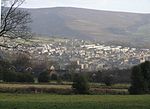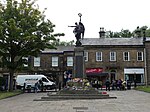St Philip Howard Catholic Voluntary Academy
1961 establishments in EnglandAcademies in DerbyshireCatholic secondary schools in the Diocese of NottinghamEducational institutions established in 1961Glossop ... and 2 more
Secondary schools in DerbyshireUse British English from February 2023
St Philip Howard Catholic Voluntary Academy (formerly St Philip Howard Catholic School) is a Roman Catholic secondary school located in Glossop in northern Derbyshire.
Excerpt from the Wikipedia article St Philip Howard Catholic Voluntary Academy (License: CC BY-SA 3.0, Authors).St Philip Howard Catholic Voluntary Academy
Sunlaws Street, High Peak Whitfield
Geographical coordinates (GPS) Address Phone number Website External links Nearby Places Show on map
Geographical coordinates (GPS)
| Latitude | Longitude |
|---|---|
| N 53.4421 ° | E -1.9568 ° |
Address
St Philip Howard Catholic Voluntary Academy
Sunlaws Street
SK13 8DR High Peak, Whitfield
England, United Kingdom
Open on Google Maps









